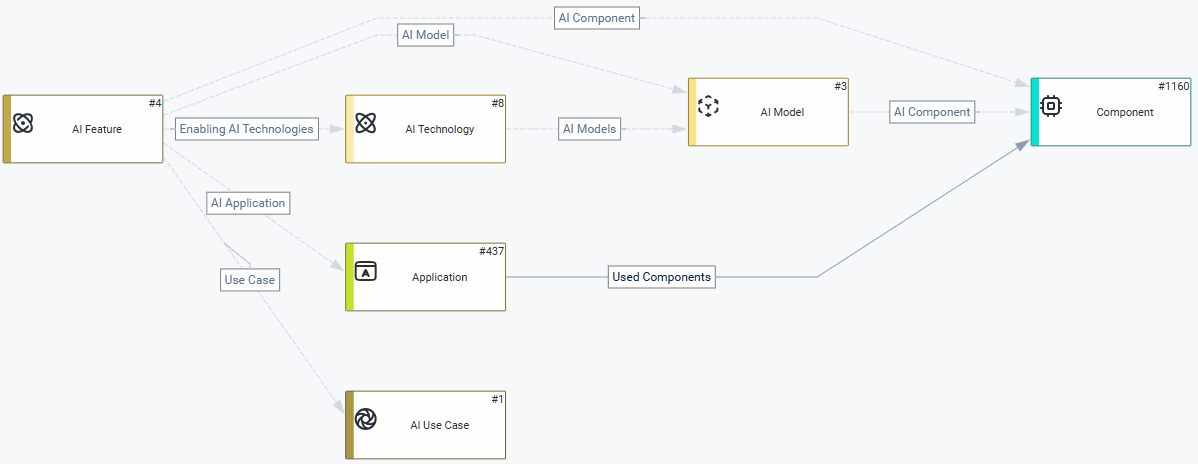Manage your AI portfolio
To work with Alfabet 's AI portfolio management capabilities, you must have a license to Enterprise Architecture Management. The use case AI Portfolio Management must be enabled. This use case includes the classes AI Use Case, AI Feature, AI Model, and AI Technology and the business questions What is our AI portfolio?, What are our AI dependencies?, and Where is AI impacting business?
AI Portfolio Management is a strategic AI governance tool designed to provide visibility into the deployment and use of artificial intelligence across your IT architecture. It enables organizations to catalog AI capabilities embedded within applications, ensuring transparency around the authorized use of underlying models and technologies. By offering a clear view of where and how AI is applied, AI portfolio management helps stakeholders understand the impact of AI on critical business segments. Risk assessment on all levels of the AI portfolio guarantees transparency to prevent black-box decision-making about AI technologies. The specification of where AI can be used in the enterprise ensures regulatory and legal compliance with the AI laws in the company's different geographical regions. A dedicated approval workflow makes certain that all aspects of the AI portfolio are approved, and each AI use case is reviewed by the responsible role in terms of the AI architecture as well as legal, data privacy, and security issues.
Business questions provide a single source of truth about the AI portfolio and keep you up-to-date on the applications and components providing AI features and technologies and the risk level of the AI features, analyze the impact of changes to the AI portfolio, and assess whether AI use is aligned with business needs. Alfabet 's AI portfolio management provides a clear view of how AI initiatives influence your business, highlighting which segments of the business are most affected. It ensures your organization strikes the right balance between innovation, safeguarding data privacy, and maintaining AI compliance.

- An AI use case describes the capabilities and technologies used to achieve a defined business goal in the enterprise using artificial intelligence such as enabling a customer support chatbot and agentic approvals are examples of AI use cases. When applying AI governance, the AI use case is the level typically used to drive approval of AI usage in the organization. An AI use case bundles various AI features.
- An AI feature is a business instantiation of an AI technology to support an AI use case. It is provided by a business application. An AI feature answering support questions needs AI technologies such as Text Classification, Machine Translation, and Question Answering enriched with business context and data.
- An AI model is a program trained on data to recognize patterns, make predictions, or perform tasks autonomously without needing explicit human instructions for each decision. Typical AI models are Chat GPT, Claude, or Gemini. An AI model provides various AI technologies.
- An AI technology is a technical feature is used to perform a task to enable an AI feature. For example, an AI feature that answers questions in a customer support chatbot requires technologies as Text Classification, Machine Translation, and Question Answering. Translation, and Question Answering.
- An application can provide one or more AI features.
- A component can provide AI technologies and AI models that enable the AI feature.
Alfabet provides preconfigured roles that are responsible for the approval of AI use cases as well as a predefined workflow for approval of the AI use case. You can define your own process for approving AI use cases. An administrative user can configure role relevant to your enterprise and your solution designer can adapt or replace the default workflow. See the documentation on workflow configuration in Alfabet Expand.
 |
Specify the applications providing an AI feature. |
 |
Document the features and assign the applications providing them. Determine the risk level of each AI feature, whether it is enabled in your IT architecture, and in which geographic locations it is allowed or not allowed. Ensure the documentation of the AI features are complete to adhere to AI compliance. |
 |
Document the AI use cases being used by the business. Bundle the AI features in relevant use cases to understand what they accomplish for the enterprise. |
 |
Create an inventory of AI models, approving the models that can be used and where they can be used. Assign AI models to the AI features using them and to the components that provide them. |
 |
Define the AI technologies being provided by AI models and being leveraged by the AI features. Specify the components that provide the AI technologies. |
 |
Assess the risk level of each AI use case. Trigger an approval workflow to ensure all responsible roles review the AI use case. and. Review whether the AI use case has been approved or not approved in terms of its architecture, legality, data privacy, and security. |
 |
Analyze the level of risk the AI portfolio poses to your enterprise. |
 |
Understand the dependencies between business capabilities and the AI architecture including AI use cases, AI features, AI models, and AI technologies. |
 |
Analyze which mission critical business capabilities are impacted by AI technologies. |